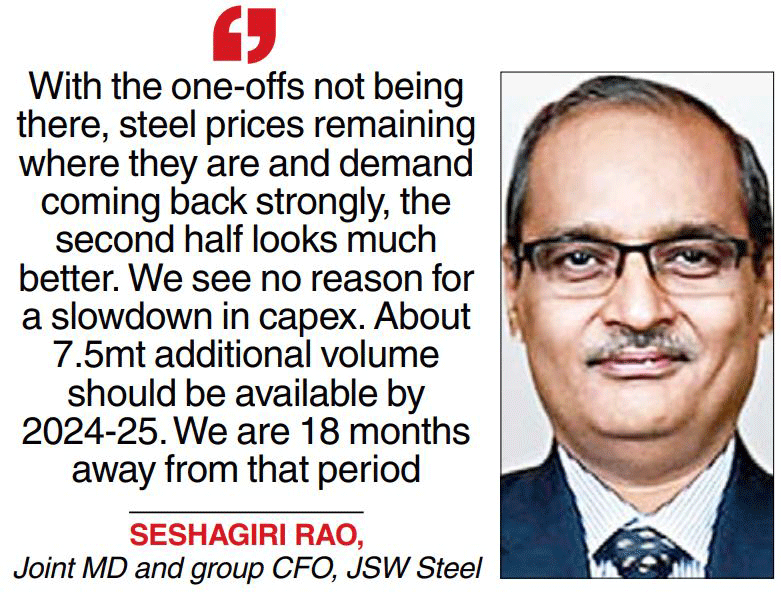JSW Steel plunged to a loss in Q2 on the back of a triple whammy of a rapid fall in the steel price, falling rupee against the dollar and an export duty. In a post-result conversation with Sambit Saha of The Telegraph, Seshagiri Rao, joint managing director and group CFO, holds out hope that the second half of the fiscal would be better as the company will have extra volume, a lower inventory loss amidst strong domestic demand. An excerpt:
■ What were the factors that led to the loss?
Higher inventory cost went into consumption, the effect of which is quite visible. Over and above that, we had the issue of non-availability of iron ore, a logistic challenge due to heavy monsoon.
The impact was mostly felt in BPSL and in the Dolvi plant. The one-off items this quarter have been Rs 1,480 crore. They include Rs 334 crore of forex loss, Rs 63 crore on export duty and Rs 1,083-crore inventory loss on finished goods.
■ You had anticipated export duty to be withdrawn. It did not happen.
We don’t know how long the export duty will remain even though there is optimism that it will not be permanent. WPI inflation has come down from 15.4 per cent in April to 10.7 per cent. Steel has a weightage of 3.22 per cent in WPI.
In April, the government of India had shown inflation from steel at 27 per cent. The steel inflation has come down to 4.5 per cent in September. It means the objective of reducing inflation overall, particularly on the WPI side which is linked to industry, is on a downward trajectory.

If you take the SteelMint number, flat steel prices are down 14 per cent Y-o-Y in September. Assuming that there is a lag in government data, hopefully it will soon be evident that steel is not contributing at all to inflation.
■ Do you expect forex and inventory losses to recur?
Whether there will be further depreciation in the rupee and there will still be some more forex losses is anybody’s guess but I do not see very big depreciation from the current levels based on fundamentals.
Coking coal is now at $300 a tonne. There is a $80 a tonne reduction in coking coal price for JSW in Q3 over Q2. We will get the benefit of coking coal price reduction as well as a fall in iron ore prices.
The losses on account of inventory will be limited as we have brought it down.
■ With this in the background, will the second half be better?
With the one-offs not being there, steel prices remaining where they are and demand coming back strongly, the second half looks much better.
■ Where are the demands coming from?
Demand in the first half was 55.43 million tonnes (mt) in India, against 49.75 mt in the same period last year, translating to a growth of 11.5 per cent.
Last year, second half demand was 56.5mt. I am expecting a 6.5 per cent growth over the second half of last fiscal, which comes to about 60mt steel demand. Be it infrastructure such as Metro, bridges, equipment — tractor, dumper, coaches, auto and residential real estate, there is robust demand post monsoon.
■ How can JSW benefit from the extra volume India will need?
There are three areas. Dolvi’s capacity utilisation will go up, additional volume will come from BPSL whose capacity is going up from 2.7mt to 3.5mt. Vijaynagar’s utilisation will also go up.
■ Will you be able to meet the guidance?
We had guided 25mt production including JSW Ispat Special (erstwhile Monnet) and Ohio in the US. We have done 11.6mt in the first half. We will achieve 23.6mt for sure. There may be some problems with Monnet and Ohio to achieve their annual production target .
■ Is the worst behind or there are still some trouble spots around?
Globally, things are not good. Every quarter growth projections are getting slashed. India is in a bright spot. The south east Asia region and MENA (Middle East and North Africa) are also looking okay. There will be 10-12mt growth in the region against 40mt fall in the overall demand. There is some opportunity for export. Despite the duty, we exported 5.6 lakh tonnes in Q2.
■ With EBITDA fallen, are you comfortable with debt level?
There are three things to look at. If we see the covenantsJSW signed, the debt to EBITDA ratio is 4.1. Our guidanceis 3.75 to the market, where wewill certainly not go.
Our internal target is2.75 and we are at 2.7. We are working towards keeping at that level. On an absolute level, Rs 2,500 crore reduction in debt is possible, by the liquidation of inventory (4 lakh tonnes).
■ Is there a case to slowdown capex in this environment?
We see no reason. About7.5mt additional volume should be available by 2024- 25. We are 18 months away from that period. I do not see the environment will remain depressed for that period.
Therefore, there will not be any moderation in capex. We will meet the Rs 15,000-crore capex target for FY23.










